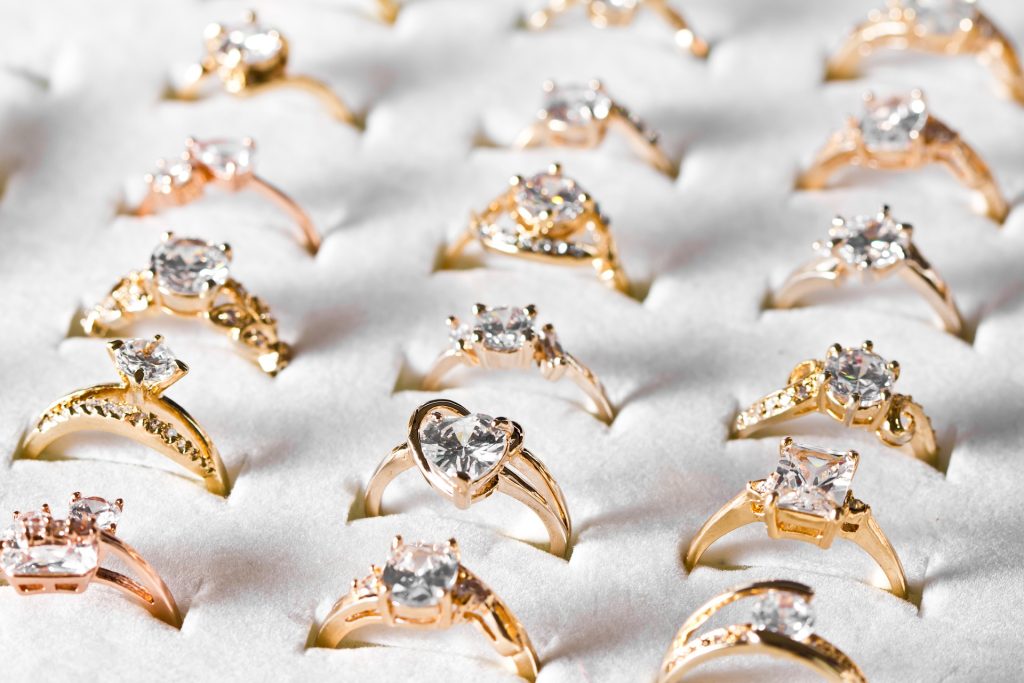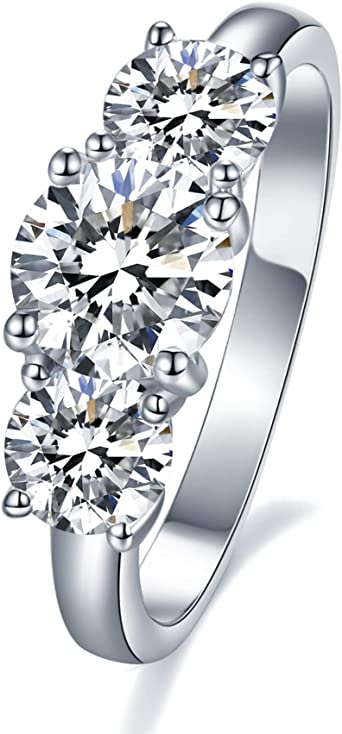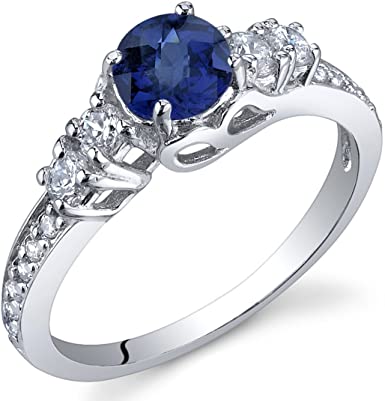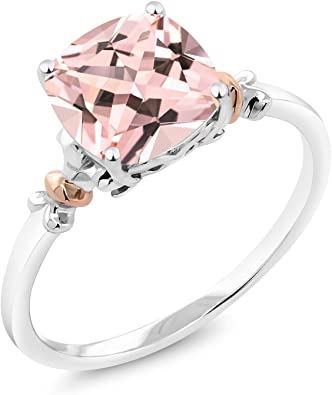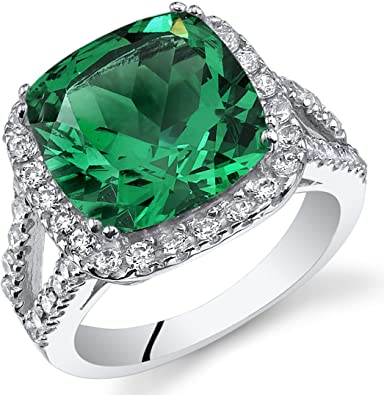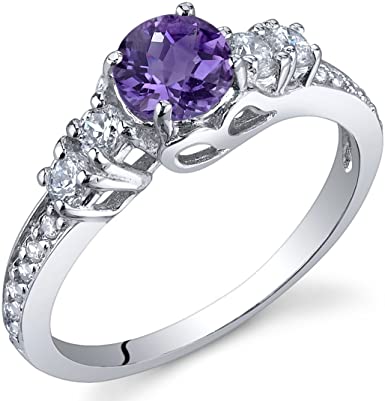When it comes to engagement rings, diamond substitutes are having a renaissance. A reason why diamonds are considered such a classic choice when it comes to engagement rings is because of their brilliance. Diamonds, one of the strongest naturally occurring substances on the planet and capable of withstanding practically anything, represent eternal love and commitment that can only be found in marriage. Diamonds aren’t always the perfect option for every occasion or person for all of their durability and beauty. If you’re looking for a less expensive or more unusual engagement ring, you might want to think about a diamond alternative instead of a traditional diamond.
It’s important to remember that you are not obligated to use a diamond as the focal stone of your engagement ring. Many gemstones are available that may be used to create stunning rings suitable for everyday use while still standing out in a crowd. When choosing a gemstone for your engagement ring, there are no hard and fast rules, and what important is that you and your spouse enjoy it! Discover some of our favorite diamond alternatives in the sections below.

What is a Diamond Alternative?
For diamond alternatives, any gemstone that a person would use instead of a diamond for an engagement ring or other fine jewelry is considered a diamond alternative. Even though most people think of diamond simulants – stones meant to mimic the appearance of diamonds – such as cubic zirconia when they think of alternatives to diamonds, there is a whole world of beautiful gemstones that we recommend as alternatives to diamonds for those looking for something different.
What is the Best Diamond Alternative?
All-Around Best Diamond Alternative
If you want to go with a non-diamond gemstone for your engagement ring, Moissanite or sapphire are good options. These jewels are sturdy enough to wear daily and come in several colors, including dazzling white.
Most Brilliant Diamond Alternative
Moissanite is your best option if you want a diamond substitute without sacrificing shine. Moissanite has a greater refractive index than diamond, ranging from 2.65 to 2.69. These stones have a flaming rainbow brilliance that gives them a lot of shine.
Most Inexpensive Diamond Alternative
The most affordable diamond replacements will be softer gemstones like morganites, aquamarines, and amethysts. While these gemstones are lovely, they should be used with discretion in a piece of jewelry that will be subjected to everyday wear and tear, such as an engagement ring or wedding band. These gemstones are significantly more prone to damage over time since they are not as durable as diamonds or other diamond alternatives. Daily wear, household soaps and cleaners, cosmetics and lotion, and exposure to other elements can all cause aquamarines and morganites to be dull with time. However, if you’re willing to put in the extra effort to care for and maintain these gemstones, they’re still lovely ring selections.
Popular Natural Diamond Alternatives
Lab-Grown Diamonds
Tracy Hall first successfully manufactured lab diamonds in the 1950s, a General Electric chemist using the tiny low-quality diamonds they had developed for industrial applications. Tracy Hall is credited with inventing the term “lab diamond.”
Lab-produced diamonds as a “diamond alternative” are a bit of a misnomer because lab-created diamonds are genuine gem-quality diamonds. Mined diamonds have physical, chemical, and visual qualities that are distinct from those of lab-grown diamonds. Gorgeous diamond gems are developed in highly controlled laboratory environments using modern technical methods that replicate the conditions that diamonds naturally develop when they form in the Earth’s mantle, deep beneath the planet’s surface. When viewed with the naked eye, a lab-grown diamond seems to be the same as a naturally mined diamond. Lab-grown diamonds are available in every color grade, cut, clarity, and form in which naturally mined diamonds are available, including flawless white D hues. Lab diamonds can only be recognized from natural diamonds with the help of specialist technology that can detect the minute changes in trace elements and crystal development between them.
Price Range
These stones are lab-created means that they are more economical than genuine diamonds of equivalent size and grade and thus represent outstanding value. If you seek a fancy colored diamond or a diamond with significant carat weight, we highly recommend looking into lab-made diamonds.
Brilliance
The brilliance of lab-grown diamonds is compared to that of genuine diamonds. The cut grade of a lab diamond, much like that of a natural diamond, will significantly impact its brilliance. Lab-grown diamonds are available in both round and fancy shapes, and they will exhibit the same variations in the brilliance that the other shapes do. An emerald-cut lab diamond will have a more brilliant sparkle than a round lab diamond, while around lab diamond will have a more reflective glitter.
Moissanites
Moissanite was first discovered in 1893 by Henri Moissan, a French chemist who went on to win the Nobel Prize in Chemistry. Moissanites were first considered diamonds, but the crystals were eventually discovered to be silicon carbide.
Moissanites are the second hardest mineral on the planet, behind diamonds, according to the Mohs scale, with a hardness of 9.5. Moissanite rings are magnificent on their own, as solitaires, or when combined with diamond accents in other designs. Learn more about the differences between Moissanite and diamonds.
Price Range
Moissanite is one of the most cost-effective diamond substitutes. While color, shape, and size can all influence the price of Moissanite, a one ct. or 6.5mm equivalent can cost anywhere between $400 and $1,000.
Brilliance
One of the most noticeable aesthetic contrasts between these gems and diamonds is the brilliance of Moissanite. Moissanites have a bright, rainbow brilliance that can create a “disco-ball” effect due to their distinctive faceting design. Many people are drawn to Moissanite because of their unusual gleam. On the other side, some buyers may be turned off by the significant difference in brilliance. Moissanite has a refractive index of 2.65 to 2.69, which is higher than diamond.
IMOLOVE Moissanite Engagement Ring, Moissanite Rings for Women Couples, 2CT Lab Created Simulated Round Diamond Engagement Rings-4
Features
- 【100% Real Moissanite with More Sparkle】-The total carat weight of the moissanite engagement ring is 2 carats, including 1 stone of 1 carat and 2 stones of 0.5 carats. It is made of 100% REAL MOISSANITE, which is as hard and shiny as a natural diamond. It won’t tarnish or discolor, and it is more cost-effective than diamond.
- 【Classic Design & Comfortable Wearing】-This silver ring for women is the most classic design and it will never go out of style. The metal of the ring is sterling silver with 18K White Gold Plated, which is 100% Hypoallergenic, Lead-free & Nickel-free. And the edges are smooth, and will not catch skin or clothes.
- 【Exquisite Craft】-The stones feature a hand-made setting instead of a wax setting, to ensure the stones are stronger and safer on the setting. No worry about the stones falling out. An excellent polishing process will make the ring have much more fire, brilliance, and sparkle.
- 【Ideal Gift】–This round solitaire ring is packed in a delicate box as a perfect gift for birthday gift, valentine’s day gift, Mother’s day gift, engagement, promise, holiday Christmas, new year bling, costume, wedding, anniversary, gifts for women, gifts for mom, gifts for mother in law, gifts for wife, gifts for daughter, gifts for aunt, dainty fine delicate gifts for best friend, grandmother, sister, girls, teens and so on. It also fits for any occasion as daily wearing home and office.
- 【90 Day Guarantee】-We offer a 90 Day No-Questions-Asked Money-Back Guarantee for the women’s wedding band. Excellent customer service.
Sapphires
Sapphires were more common than diamonds as featured jewels in engagement rings until the twentieth century. Sapphires come in various colors, including peach, pink, teal, yellow, white, and traditional royal blue.
Sapphire is a superb choice for an engagement ring not just because of its beauty but also because it is one of the world’s most durable naturally occurring elements, with a Mohs hardness of 9. The durability allows them to withstand the wear and tear that an engagement ring is subjected to daily.
Price Range
The price of sapphires, like all the other gemstones in this list, is determined by their quality, size, cut, whether it is naturally mined or lab-made, and other unique qualities. However, sapphires are often less expensive than diamonds of comparable size. Depending on the qualities and color of the sapphire, it might cost anywhere from $750 to $3,500.
Brilliance
Sapphires are a fantastic diamond alternative for an engagement ring because of their brilliant colors and rich beauty. Every sapphire is carefully cut to display the optimum color and brilliance for that particular diamond, so the brilliance of each stone will be distinct.
Created Sapphire Solstice Ring Sterling Silver
Features
- Created Blue Sapphire, Ceylon Blue Hue with Brilliant Sparkle
- The ring is in .925 Sterling Silver and finished with Rhodium
- Top Quality Craftsmanship
- Exceptional Styling
- 30 Day Return Policy
Aquamarines
Aquamarine was given its name in the early 1700s, around the beginning of the Georgian era, and it means “seawater.” Aquamarine was initially known as the “Sailor’s Stone” because ancient sailors believed it would protect them from maritime tragedies.
The semi-precious stone aquamarine is a lovely pale blue color. These lovely gems belong to the beryl mineral family, including emeralds. Aquamarine is mined in Brazil, Africa, Asia, and Colorado, where it is the official state gemstone and the birthstone for March. Although aquamarine and blue topaz are similar, aquamarine is more costly because of its rarity and natural coloration, whereas blue topaz is created by irradiating colorless topaz. Aquamarines have a hardness rating of 7.5-8 on the Mohs scale, indicating that they are durable enough to wear as jewelry but should be protected from scratches.
Price Range
Aquamarines are one of the more cost-effective semi-precious gemstones, with a 6.5mm (1-carat equivalent) aquamarine costing roughly $700. Because deep colors are regarded as the most precious, the color intensity will be the essential component in determining price.
Brilliance
Aquamarines are prized for their stunning shade of blue and remarkable clarity, but they aren’t noted for their brilliance or glitter. Aquamarines are prized for their delicate blue color and organic look in ring settings by those who prefer them to something with more excellent sparkle.
Aquamarine Homage Ring in 14K Yellow Gold (1.50 carat)
Features
- 8x8mm Trillion Cut Genuine Aquamarine
- Genuine White Topaz accent stones
- Eye-clean clarity (without visible inclusions)
- 14K Yellow Gold with a high polish
- Birthstone for the month of March
Morganites
Morganites were first discovered in Madagascar in 1922 as a new type of pink beryl and were dubbed “rose beryl” at the time. To commemorate his benefactor, American financier and philanthropist J.P. Morgan, gemologist George Frederick Kunz dubbed it “morganite.”
As the centerpiece of an engagement ring, blush-hued Morganite is stunning. Morganite is a beryl variation that ranges from pink to peach in color, and emeralds and aquamarines are two other well-known beryl types. Like other beryl variations, Morganite is a softer stone that rates 7.5 to 8 on the Mohs hardness scale. While this stone is robust enough to be used in jewelry, it should be handled cautiously.
Price Range
Morganites are a popular choice for individuals looking for pink gems at a lower price because they are inexpensive. A 1-carat morganite gemstone is usually between $400 and $500.
Brilliance
They are prized for their brilliant clarity and a significant degree of brilliance, and their lovely hue. Morganite and rose gold enhance each other’s warm undertones, making for a beautiful combination.
Gem Stone King 2.00 Ct Cushion Peach Nano Morganite 925 Sterling Silver and 10K Rose Gold Ring
Features
- MEASUREMENTS: 8x8mm Cushion Peach Nano Morganite. The total Carat weight is 2.00 cttw.
- CRAFTED: in 925 Sterling Silver with 925 stamps.
- USA-BASED COMPANY AND SERVICE: Our jewelry passes extensive quality checkpoints before being shipped to you. In the (very) unlikely event that you aren’t satisfied, simply return for a 100% refund.
- EXCELLENT GIFT: for birthday, anniversary, holidays, stocking stuffers, graduation, Christmas, Valentine’s Day, Mother’s Day, Thank You, or simply ”Thinking of You”
- INCLUDES WITH ORDER: All of our items come in the appropriate packaging ensuring they are ready for gifting upon arrival. Our packaging ranges from gorgeous cardboard boxes with foam inserts for security, to sleek wood finish boxes with plush inserts.
Emeralds
Emeralds are one of the rarest gemstones and make a stunning center stone for an engagement ring. Emeralds, diamonds, rubies, pearls, and sapphires have long been valuable stones, and emeralds are the most famous and coveted green gemstones.
Emeralds, like aquamarines and morganites, are a type of beryl. When beryl contains iron, chromium, and vanadium, emeralds develop. Emeralds with more iron have a slight blue tinge, but emeralds with more chromium and vanadium have a vivid green color.
Price Range
Natural emeralds of high quality can be appraised and priced similarly to diamonds of similar characteristics. Finding a stunning emerald diamond within a specified price range, on the other hand, is not difficult. Choosing an emerald made in a lab will also save you money. An emerald with a carat weight of about 1 carat will cost between $1,000 and $3,000.
Brilliance
Unlike diamonds, emerald clarity is graded with the naked eye since inclusions are apparent. There will be inclusions in natural emeralds compared to lab-grown emeralds, and many people admire the ancient and organic beauty of natural emeralds. Unlike genuine emeralds, lab-manufactured emeralds are usually much brighter and more transparent. Lab emeralds are marginally more durable than natively mined emeralds due to fewer inclusions.
6.50 Carats Cushion-Cut Simulated Emerald Ring Sterling Silver Sizes 5 to 9
Features
- Simulated Emerald, Rich Forest Green Hue with Brilliant Sparkle
- The ring is in Sterling Silver
- Available in Sizes 5 to 9
- Exclusive Craftsmanship and Styling
- Includes Gift Packaging
Rubies
For thousands of years, rubies have been prized for their unusual beauty, like diamonds, sapphires, and emeralds. They are one of the four original gemstones, along with diamonds, sapphires, and emeralds. Ruby is an appropriate focal point for an engagement ring because red has traditionally been connected with love and passion.
Rubies, like sapphires, are a kind of corundum. The red hue of rubies is caused by trace elements of chromium in the crystal structure, which appear to glow from within. These lovely stones have a hardness rating of 9 on the Mohs scale, making them excellent for everyday jewelry.
Price Range
Natural rubies are among the most expensive colored gemstones due to their beauty and history. The most crucial aspect that influences the price of a ruby is its color, followed by clarity, cut quality, and dimensions. With a carat weight of about 1 carat, Ruby will cost between $1,200 and $1,500.
Brilliance
Rubies are brilliant stones, yet their color and clarity are valued more than their overall radiance. Light passing through will produce more shimmer than reflecting sparkle due to their deep color. Lab-made rubies, like emeralds, will have fewer inclusions and reflect more light than natural rubies.
14K White Gold Created Ruby Heart Solitaire Ring 2.25 Carat
Features
- Lab-Created Ruby, Pigeon Blood Red Hue with Brilliant Sparkle
- Classic Solitaire Design
- 14 Karat White Gold
- Made in the USA
- Exclusive Styling, Gift Box, 30 Day Return Policy
Amethyst
Amethysts have always been revered, with archaeologists discovering amethyst jewelry dating to 2000 BC. This mysterious stone is also linked to several legends.
Amethysts are available in various colors, from deep purple to light lavender and pink. Although a rich reddish-purple tone is the most precious, we adore all shades of amethyst! When paired with diamond accents, lavender colors in amethyst engagement rings appear incredibly gorgeous. Amethysts have a Mohs hardness of 7, making them a long-lasting alternative for jewelry; nonetheless, they should be handled cautiously in settings that will see a lot of daily wear.
Price Range
Amethysts are one of the cheapest gemstones available, and they provide exceptional value for money. The price of about 1-carat amethyst is usually less than $500, depending on the specific traits and attributes of the stone.
Brilliance
Generally speaking, the purity of amethysts is exceptional, with no inclusions visible to the naked eye. They are also available in various shapes and carat weights to suit your needs.
Peora Enchanting 0.50 Carats Amethyst Ring in Sterling Silver Sizes 5 to 9
Features
- Genuine Amethyst, Royal Purple Hue with Brilliant Sparkle
- The ring is in .925 Sterling Silver and finished with Rhodium
- Top Quality Craftsmanship
- Exceptional Styling
- 30 Day Return Policy
Which Mined-Diamond Option Should I go with?
There is no single diamond substitute that will be suitable for everyone, and there are significant differences between each option in terms of pricing, aesthetics, and durability. If you’re searching for something that will last a long time (for example, in an engagement ring), your options are pretty restricted.
Moissanite is the most cost-effective option for consumers looking for the best value for lab-created stones. A lab-created diamond is also an excellent choice for people with a somewhat larger budget.
If you have your heart set on a natural, mined stone, no substitute can compare to the beauty of a diamond. White sapphire comes the closest in terms of brilliance and durability, but be careful to get a mined stone rather than one created in a lab.
If you’re looking for an emerald or Asscher-cut gemstone where brightness isn’t as critical, goshenite can be an excellent alternative to diamond, especially at a reduced price.
Is Moissanite a Viable Diamond Substitute?
In most people’s eyes, Moissanite is virtually indistinguishable from diamond—and it costs a fraction of the price. On the Mohs scale, the rating is 9.25. Moissanite is extremely scratch-resistant on the Mohs scale of hardness. Because of its endurance is known as a ‘forever’ stone because it can withstand daily use and last for generations. This means that Moissanite is an excellent choice for an engagement ring because it will retain its *sparkly* appearance even after being worn for a lifetime.
Is there a Ring that isn’t an Engagement Ring?
The timeless elegance of classic bracelets makes them an excellent alternative to diamond rings for your engagement proposal. A delicate tennis bracelet or a nostalgic charm piece would function as an equally particular piece of jewelry that they could wear daily without feeling self-conscious.
What Gemstone is More Valuable than a Diamond?
White sapphire is unquestionably the best choice when it comes to genuine diamond alternatives. When comparing white sapphire sparkle to the white and colored sparkling diamond sparkle, those who choose white sapphire should expect simply white shine.
You should consider Moissanite if you want a diamond substitute but don’t want to sacrifice brilliance. Moissanite has a refractive index ranging from 2.65 to 2.69, higher than the refractive index found in the diamond. These stones have a flaming, rainbow-colored brilliance, which results in a brilliant shine.
Conclusion
Engagement ring diamond alternatives are cheaper than diamond engagement rings, but they are also more commonly available. You can choose between white sapphire, and glistening Moissanite is your gemstone. These gemstones have a higher hardness level than diamonds, so they are better suitable for everyday use. Aside from being reasonably priced, they are also available in various colors. Choose the hue of gemstone that best suits your preferences and your financial constraints. You might be surprised to learn that the ideal gemstone can be found at a reasonable price in your area.

